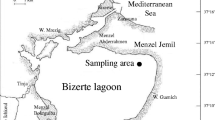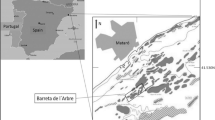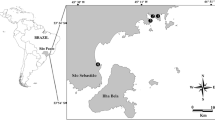Abstract
Gastropod assemblages associated with eight common macroalgae from the hard-bottom subtidal communities near Palmer Station, western Antarctic Peninsula, were investigated in order to establish a species inventory and determine abundance, distribution, and diversity. Four different sites within the area were sampled. Using SCUBA, selected algae were gently removed from the substrate and enclosed in a fine mesh bag. Shortly thereafter, all epibionts were removed and preserved. Twenty-one different gastropod taxa were identified, two of which not to species level. A total of 3486 individuals were quantified with Skenella umbilicata the numerically dominant, followed by Laevilacunaria antarctica and Eatoniella calignosa. Most individuals (86 %) were <0.5-mm shell length; the largest specimens did not exceed 20-mm shell length. No difference in gastropod species abundance or species diversity was observed between the algal species. Mean densities of a given species of gastropod associated with a given algal species ranged from 0 to 38 individuals per 100 g wet wt of sampled alga with no discernable pattern of algal host preference. Additionally, no consistent pattern of gastropod community composition with either associated macroalgal species or collection site was demonstrated with a non-metric multidimensional scaling analysis. Gastropods may, however, work in concert with other epibionts, in particular amphipod assemblages, to in some way benefit the host alga. Specifically, gastropods may contribute to enhancing the photosynthetic capacity of the host alga by grazing upon fouling epiphytic microalgae and emerging endophytic filaments.



Similar content being viewed by others
References
Amsler CD, Rowley RJ, Laur DR, Quetin LB, Ross RM (1995) Vertical distribution of Antarctic peninsular macroalgae: cover, biomass and species composition. Phycologia 34:424–430
Amsler CD, McClintock JB, Baker BJ (2008) Macroalgal chemical defenses in polar marine communities. In: Amsler CD (ed) Algal chemical ecology. Springer, Berlin, pp 91–100
Amsler CD, Amsler MO, McClintock JB, Baker BJ (2009) Filamentous algal endophytes in macrophytic Antarctic algae: prevalence in hosts and palatability to mesoherbivores. Phycologia 48:324–334
Amsler MO, Amsler CD, von Salm JL, Aumack CF, McClintock JB, Young RM, Baker BJ (2013) Tolerance and sequestration of macroalgal chemical defenses by an Antarctic amphipod: a ‘cheater’ among mutualists. Mar Ecol Prog Ser 490:79–90
Amsler CD, McClintock JB, Baker BJ (2014) Chemical mediation of mutualistic interactions between macroalgae and mesograzers structure unique coastal communities along the western Antarctic Peninsula. J Phycol 50:1–10
Anderson MJ, Walsh DCI (2013) PERMANOVA, ANOSIM, and the Mantel test in the face of heterogeneous dispersions: What null hypothesis are you testing? Ecol Monogr 83:557–574
Arnaud PM, Hain S (1992) Quantitative distribution of the shelf and slope molluscan fauna (Gastropoda, Bivalvia) of the eastern Weddell Sea (Antarctica). Polar Biol 12:103–109
Aronson RB, Thatje S, Clarke A, Peck LS, Blake DB, Wilga CD, Seibel BA (2007) Climate change and invasibility of the Antarctic benthos. Ann Rev Ecol Evol 38:129–154
Arrontes J (1999) On the evolution of interactions between marine mesoherbivores and algae. Bot Mar 42:137–155
Chapelle G, Peck LS (1999) Polar gigantism dictated by oxygen availability. Nature 398:114–115
Chemello R, Milazzo M (2002) Effect of algal architecture on associated fauna: some evidence from phytal molluscs. Mar Biol 140:981–990
Clarke KR, Gorley RN (2006) Primer-E. Plymouth Marine Laboratory, Plymouth
Clarke KR, Warwick RM (2001) Change in marine communities: an approach to statistical analysis and interpretation, 2nd edn. PRIMER-E, Plymouth, p 172
Clarke A, Griffiths HJ, Linse K, Barnes DKA, Crame JA (2007) How well do we know the Antarctic marine fauna? A preliminary study of macroecological and biogeographical patterns in Southern Ocean gastropod and bivalve molluscs. Divers Distrib 13:620–632
DeLaca TE, Lipps JH (1976) Shallow-water marine associations, Antarctic Peninsula. Antarct J US 11:12–20
Dell RK (1964) Antarctic and subantarctic Mollusca: Amphineura, Scaphopoda and Bivalvia. Cambridge University Press, Cambridge
Dell RK (1990) Antarctic Mollusca with special reference to the fauna of the Ross Sea. Bull R Soc NZ 27:1–311
Duffy JE, Hay ME (2000) Strong impacts of grazing amphipods on the organization of a benthic community. Ecol Monogr 70:237–263
Engl W (2012) Shells of Antarctica. Conchbooks, Hackenheim
Gambi MC, Lorenti M, Russo GF, Scipione MB (1994) Benthic associations of the shallow hard bottoms off Terra Nova Bay, Ross Sea: zonation, biomass and population structure. Antarct Sci 6:449–462
Griffiths HJ, Linse K, Crame JA (2003) SOMBASE–Southern Ocean Mollusc Database: a tool for biogeographic analysis in diversity and ecology. Org Divers Evol 3:207–213
Gutow L, Giménez L, Boos K, Saborowski R (2009) Rapid changes in the epifaunal community after detachment of buoyant benthic macroalgae. J Mar Biol Assoc UK 89:323–328
Huang YM, Amsler MO, McClintock JB, Amsler CD, Baker BJ (2007) Patterns of gammaridean amphipod abundance and species composition associated with dominant subtidal macroalgae from the western Antarctic Peninsula. Polar Biol 30:1417–1430
Iken K (1996) Trophische Beziehungen zwischen Makroalgen und Herbivoren in der Potter Cove (King George Island, Antarctica). Ber Polarforsch 201:1–206
Iken K (1999) Feeding ecology of the Antarctic herbivorous gastropod Laevilacunaria antarctica Mertens. J Exp Mar Biol Ecol 236:133–148
Iken K, Barrera-Oro ER, Quartino ML, Casaux RJ, Brey T (1997) Grazing in the Antarctic fish Notothenia coriiceps: evidence for selective feeding on macroalgae. Antarct Sci 9:386–391
Iken K, Quartino ML, Wiencke C (1999) Histological identification of macroalgae from stomach contents of the Antarctic fish Notothenia coriiceps using semi-thin sections. Mar Ecol 20:11–17
Johnson CR, Mann KH (1986) The importance of plant defence abilities to the structure of subtidal seaweed communities: the kelp Laminaria longicruris de la Pylaie survives grazing by the snail Lacuna vincta (Montagu) at high population densities. J Exp Mar Biol Ecol 97:231–267
Linse K, Griffiths HJ, Barnes DKA, Clarke A (2006) Biodiversity and biogeography of Antarctic and sub-Antarctic mollusca. Deep-Sea Res 53:985–1008
Majewska R, Gambi MC, Totti CM, De Stefano M (2013a) Epiphytic diatom communities of Terra Nova Bay, Ross Sea, Antarctica: structural analysis and relations to algal host. Antarct Sci 25:501–513
Majewska R, Gambi MC, Totti CM, Pennesi C, De Stefano M (2013b) Growth form analysis of epiphytic diatom communities of Terra Nova Bay (Ross Sea, Antarctica). Polar Biol 36:73–86
McCune B, Grace JB, Urban DL (2002) Analysis of ecological communities, vol 28. MjM Software Design, Gleneden Beach
Nicol D (1978) Size trends in living pelecypods and gastropods with calcareous shells. Nautilus 92:70–79
Peters AF (2003) Molecular identification, taxonomy and distribution of brown algal endophytes, with emphasis on species from Antarctica. Proc Int Seaweed Symp 17:293–302
Picken GB (1980) The nearshore prosobranch gastropod epifauna of Signy Island, South Orkney Islands. PhD Dissertation, University of Aberdeen
Richardson M (1977) The ecology (including physiological aspects) of selected Antarctic marine invertebrates associated with inshore macrophytes. PhD Dissertation, University of Durham
Schiaparelli S, Linse K (2014) Gastropoda. In: De Broyer C, Koubbi P, Griffiths HJ, Raymond B, d’Udekem d’Acoz C, Van de Putte AP, Danis B, David B, Grant S, Gutt J, Held C, Hosie G, Huettmann F, Post A, Ropert-Coudert Y (eds) Biogeographic Atlas of the Southern Ocean. SCAR, Cambridge, pp 122–125
Schiel DR, Foster MS (1986) The structure of subtidal algal stands in temperate waters. Oceanogr Mar Biol Ann Rev 24:265–307
Schram JB, McClintock JB, Amsler CD, Baker BJ (2015) Impacts of acute elevated seawater temperature on the feeding preferences of an Antarctic amphipod toward chemically deterrent macroalgae. Mar Biol 162:425–433
Sokal RR, Rohlf FJ (1995) Biometry. WH Freeman, New York
Steneck L, Watling L (1982) Feeding capabilities and limitation of herbivorous molluscs: a functional group approach. Mar Biol 68:299–319
Tuya F, Wernberg T, Thomsen MS (2009) Colonization of gastropods on subtidal reefs depends on density in adjacent habitats, not on disturbance regime. J Molluscan Stud 75:27–33
Underwood AJ (1980) The effects of grazing by gastropods and physical factors on the upper limits of distribution of intertidal macroalgae. Oecologia 46:201–213
Watson S-A, Peck LS, Tyler PA, Southgate PC, Tan KS, Day RW, Morley SA (2012) Marine invertebrate skeleton size varies with latitude, temperature and carbonate saturation: implications for global change and ocean acidification. Glob Change Biol 18:3026–3038
Wiencke C, Amsler CD (2012) Seaweeds and their communities in polar regions. In: Wiencke C, Bischof K (eds) Seaweed biology: novel insights into ecophysiology, ecology and utilization. Springer, Berlin, pp 265–294
Wiencke C, Amsler CD, Clayton MN (2014) Macroalgae. In: De Broyer C, Koubbi P, Griffiths HJ, Raymond B, d’Udekem d’Acoz C, Van de Putte AP, Danis B, David B, Grant S, Gutt J, Held C, Hosie G, Huettmann F, Post A, Ropert-Coudert Y (eds) Biogeographic Atlas of the Southern Ocean. SCAR, Cambridge, pp 66–73
Williams GA (1993) Seasonal variation in algal species richness and abundance in the presence of molluscan herbivores on a tropical rocky shore. J Exp Mar Biol Ecol 167:261–275
Williams GA, Seed R (1992) Interactions between macrofaunal epiphytes and their host algae. In: John DM, Hawkins SJ, Price JH (eds) Plant–animal interactions in the marine benthos. Clarendon, Oxford, pp 189–211
Young RM, von Salm JL, Amsler MO, Lopez-Bautista J, Amsler CD, McClintock JB, Baker BJ (2013) Site-specific variability in the chemical diversity of the Antarctic red alga Plocamium cartilagineum. Mar Drugs 11:2126–2139
Zamzow JP, Amsler CD, McClintock JB, Baker BJ (2010) Habitat choice and predator avoidance by antarctic amphipods: the roles of algal chemistry and morphology. Mar Ecol Prog Ser 400:155–163
Acknowledgments
Field assistance from Anne Fairhead and Kevin Peters is gratefully acknowledged as well as the outstanding logistical support provided by employees Raytheon Polar Services Company while in Antarctica. Anonymous reviewers and Nicole Riddle provided valuable input greatly improving the manuscript. This research was supported by the Office of Polar Programs of the National Science Foundation to JBM and CDA (OPP-0125181; ANT-0838773; and ANT-1041022). JBM wishes to acknowledge the support of an Endowed University Professorship in Polar and Marine Biology provided by the University of Alabama at Birmingham.
Author information
Authors and Affiliations
Corresponding author
Rights and permissions
About this article
Cite this article
Amsler, M.O., Huang, Y.M., Engl, W. et al. Abundance and diversity of gastropods associated with dominant subtidal macroalgae from the western Antarctic Peninsula. Polar Biol 38, 1171–1181 (2015). https://doi.org/10.1007/s00300-015-1681-4
Received:
Revised:
Accepted:
Published:
Issue Date:
DOI: https://doi.org/10.1007/s00300-015-1681-4




